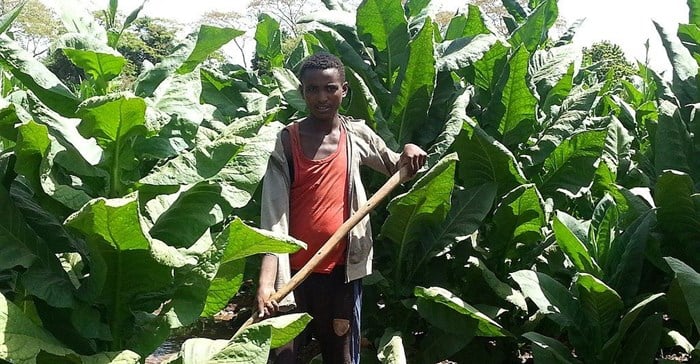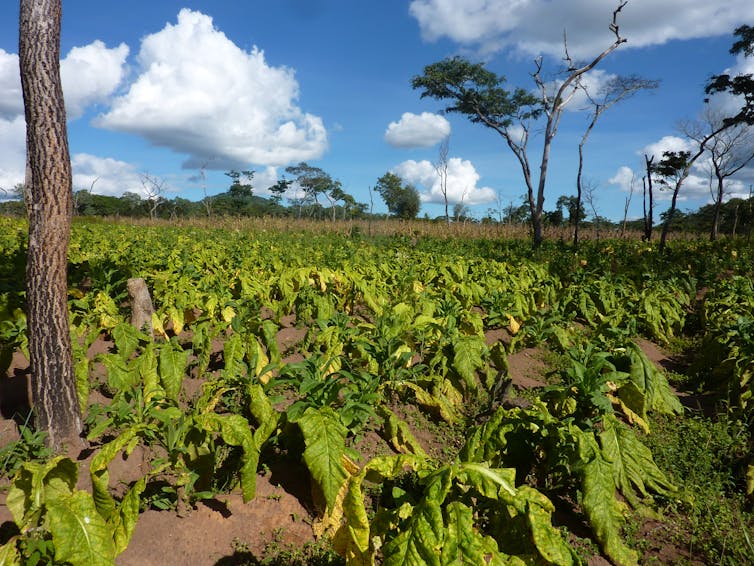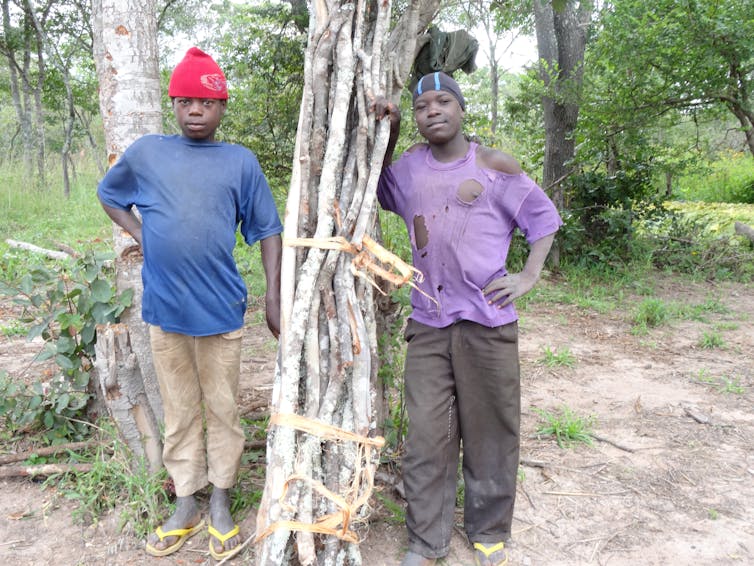Tobacco hurts more than just your lungs - it damages the communities that grow it

Just the word “tobacco” conjures up vivid imagery of death and disease, as depicted on graphic cigarette packets and through hard-hitting anti-smoking campaigns. But tobacco’s impact starts long before it is found wrapped in a cigarette, and affects many more people than the estimated one billion smokers worldwide.
Tobacco also impacts the health and well-being of the people who grow it and the environment where it is grown, often with devastating consequences. My colleagues and I have recently published research demonstrating just how damaging it can be to the environment and communities in rural Tanzania.
Most villages in Kipembawe don’t have electricity or mobile phone coverage. There are minimal healthcare facilities, and water is obtained from wells and rivers. There are few crops people can grow to make money and the dominant one is tobacco, farmed by 86% of the 196 households we surveyed. In Tanzania, 47% of the population lives below the international poverty line and rural poverty rates are even higher, where most people are reliant on agriculture.
Nutrient-hungry crop.
Eleanor Jew
In Africa, tobacco cultivation is often associated with the presence of a dry tropical woodland called “miombo”, which dominates Kipembawe. Miombo woodland covers over 2.4m km² in Africa, but is undergoing rapid deforestation and degradation throughout its range. Both tobacco and miombo trees like sandy, slightly acidic soils.
Unfortunately, these soils don’t contain many nutrients, and tobacco is one of the most nutrient-hungry crops there is. This means farmers must clear more woodland almost every year to create new fields because the land can only support one or two cropping cycles.
For tobacco leaves to be preserved for transportation and further processing they must be dried or cured. This places another burden on the trees, which are used for fuel. In total, approximately 4,134 hectares of woodland are cleared annually within Kipembawe. This reduces biodiversity and the benefits the local environment can provide people, including carbon storage, firewood, building materials and fresh water.
Risks to farmers
But woodland clearance is just the start of the process. Throughout the growing season, farmers apply several rounds of fertiliser and pesticides to the crop, yet few farmers understand the risks associated with their use. During our time in Kipembawe, we didn’t see anyone using protective clothing or equipment, exposing farmers, families and labourers to harmful chemicals.
What’s more, despite regulations that aim to reduce the impact of fertilisers on water sources, the crops are often initially grown close to rivers so that the distance to carry water is shorter. This means the only source of drinking water for livestock can become contaminated, causing conflict between livestock keepers and tobacco farmers.
Young farmers.
Eleanor Jew, Author provided
Child labour within tobacco growing is also a well-known issue, and the main tobacco organisations have joined the Eliminating Child Labour in Tobacco Growing Foundation. But we saw children working in the fields, and evidence from primary schools indicates that children are likely to start working on their parents’ fields from around the age of 13.
While this has obvious consequences for their education, there are also severe health impacts. Green tobacco sickness is a form of nicotine poisoning that occurs when the tobacco leaves are wet and contacts the skin. Nicotine is absorbed through the skin and leads to fever, vomiting and dizziness. While it rarely results in death it can be extremely frightening to children, who are more susceptible to severe symptoms due to a lack of nicotine tolerance and smaller body size.
Little other choice
So why do farmers grow tobacco? Many people have few alternative ways to make a living and farmers can get a good price for top quality tobacco. This money can significantly improve the lives of the farmers, enabling them to pay school fees, invest in other businesses, and afford bicycles and solar electricity.
Some men spend their money during the weeks after harvest drinking in the local pubs and pop-up bars which emerge. Canny women brew home beer from maize and make a roaring trade. But prostitutes also flock to the area around this time, raising the risk of STI transmission. HIV rates in Mbeya are the third highest in the country, with 9% of 15-49-year-olds testing positive for HIV – 4% higher than the national average.
Crop collectors.
Eleanor Jew, Author provided
Despite the 2005 World Health Organisation’s Framework Convention on Tobacco Control and falling smoking rates, global population growth means total tobacco use looks likely to keep rising in the foreseeable future. But in Kipembawe, the deforestation associated with tobacco cultivation will ultimately make production unviable because there will be no fuel left to cure the crop. This will leave the community without a significant source of income and a degraded environment.
If people had other ways to make their living, it would help reduce the social and environmental burdens of tobacco production, but opportunities are limited. Tobacco production could be made more sustainable using alternative drying methods, reforestation, more efficient use of fertilisers and pesticides and land use management plans. But extensive training and support are needed, and child labour must be eliminated.
![]() All of this will be difficult while there is such great demand for tobacco. So next time you think about lighting up, remember it’s not just your health at risk. Kicking the habit could save both trees and children’s chances.
All of this will be difficult while there is such great demand for tobacco. So next time you think about lighting up, remember it’s not just your health at risk. Kicking the habit could save both trees and children’s chances.
This article was originally published on The Conversation. Read the original article.
Source: The Conversation Africa

The Conversation Africa is an independent source of news and views from the academic and research community. Its aim is to promote better understanding of current affairs and complex issues, and allow for a better quality of public discourse and conversation.
Go to: https://theconversation.com/africaAbout Eleanor Jew
Eleanor Jew, Researcher in Conservation and Agriculture, University of LeedsRelated
Saving the bees: How Nedbank and WWF are working to ensure honeybee survival 12 Nov 2024 FMD hits 24 ECape farms, quarantine and vaccination underway 22 Jul 2024 Planting trees in grasslands won't save the planet – rather protect and restore forests 22 Apr 2024 Unanimous ruling favours Big Tech in DRC child labour cobalt claim 6 Mar 2024

























